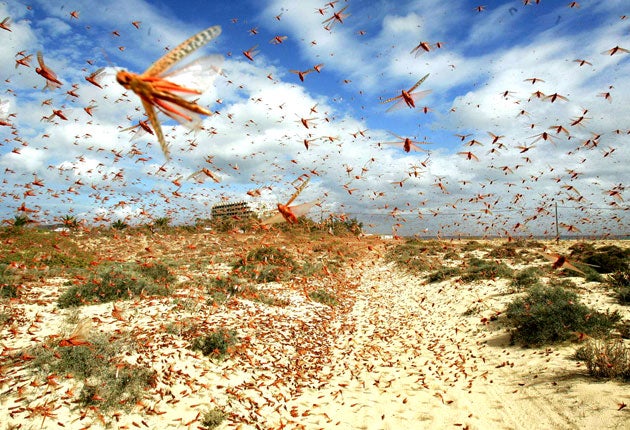Solved: the mystery of why locusts swarm
Neurochemical transforms loner insects into collective menace

Your support helps us to tell the story
From reproductive rights to climate change to Big Tech, The Independent is on the ground when the story is developing. Whether it's investigating the financials of Elon Musk's pro-Trump PAC or producing our latest documentary, 'The A Word', which shines a light on the American women fighting for reproductive rights, we know how important it is to parse out the facts from the messaging.
At such a critical moment in US history, we need reporters on the ground. Your donation allows us to keep sending journalists to speak to both sides of the story.
The Independent is trusted by Americans across the entire political spectrum. And unlike many other quality news outlets, we choose not to lock Americans out of our reporting and analysis with paywalls. We believe quality journalism should be available to everyone, paid for by those who can afford it.
Your support makes all the difference.They first became famous in the Book of Exodus as the eighth of the 10 plagues of Egypt, but it has taken another few thousand years – and the skills of modern scientists – to work out why desert locusts suddenly swarm in vast numbers.
Desert locusts usually live shy, solitary lives. But every now and again they join together in gregarious bands that actively seek out each other until they form hungry swarms. These can contain a billion or more individuals that each day can devour their own body weight, with devastating consequences for crops and vegetation.
How this dramatic transformation comes about has been a mystery since biblical times – which is why locust plagues were often seen as acts of God. Now scientists have discovered a link to a neurochemical called serotonin, found in the brains of many animals including humans.
A study by the universities of Oxford, Cambridge and Sydney has found a build-up of serotonin in the nerves of the middle part of the locust's body controlling its legs and wings causes, within the space of a couple of hours, the solitary locust to turn into its swarming alter-ego.
The finding opens the possibility of stopping the process long before it happens, by blocking the action of serotonin.
This could be used to prevent the massive destruction of crops that occurs when locusts swarm – a threat affecting the livelihoods of one-tenth of the world's population. Globally there are about a dozen species of swarm-forming locust in a belt covering some 20 per cent of the world's landmass, from north Africa to China.
Last November, a locust swarm 3.7 miles long devastated agricultural production in parts of Australia, and in 2004 half the crops of Mauritania were lost as a result of similar locust swarms.
The solitary and gregarious forms of the desert locust are so different both in looks and behaviour that they were considered to be separate species until 1921, when scientists proved otherwise.
The transition usually happens after rainfall has caused an explosion in numbers. During a subsequent drought, the solitary locusts are forced closer together on smaller patches of remaining vegetation. It is this enforced mingling that triggers the physical change from solitary to gregarious, said Steve Rogers of Cambridge University, a member of the group behind the study, which is published in the journal Science.
"The gregarious phase is a strategy born of desperation and driven by hunger – swarming is a response to find pastures new," said Dr Rogers.
"We have now found the mechanism that controls the process. We've opened the black box of how this works," he said.
Swidbert Ott, a member of the Cambridge team, said: "Serotonin profoundly influences how humans behave and interact, so to find the same chemical causes a normally shy insect to form huge groups is amazing."
The crimson tide
Holidaymakers at Fuerteventura in the Canary Islands were greeted by a terrifying sight in November 2004 when a 100 million-strong swarm of pink locusts descended from the skies (pictured above). Tourists fled the beach near the resort of Corralejo when the insects, which had laid waste to huge swaths of farmland in Mauritania, crossed the Atlantic.
3.7 miles
The length of a swarm of locusts that devastated crop production in parts of Australia last year.
Join our commenting forum
Join thought-provoking conversations, follow other Independent readers and see their replies
Comments